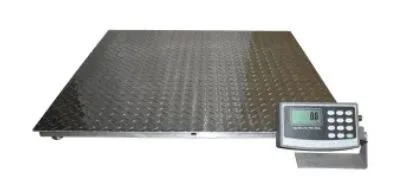Weighing in Hazardous Environments: How SAW Tech Enhances Safety
Hazardous environments—those with flammable gases, combustible dust, or volatile chemicals—pose unique challenges for industrial operations. In such settings, even routine tasks like weighing raw materials or monitoring batch processes require specialized equipment that prioritizes safety alongside performance.
Weighing systems are often embedded in critical workflows: dosing ingredients, filling drums, or monitoring tank levels. However, when these processes occur in explosive-rated areas, every component—from load cells to signal wiring—must meet strict safety standards. The risks of spark generation, thermal buildup, or mechanical failure can’t be tolerated.
Surface Acoustic Wave (SAW) technology offers an alternative approach to industrial weighing that enhances safety while maintaining high precision. Its passive sensing mechanism, minimal power requirements, and reduced need for maintenance make it well-suited for classified zones where safety and uptime are paramount.
Hazards in Industrial Weighing Applications
Weighing equipment used in hazardous environments must contend with both the physical dangers of the setting and the operational demands of continuous use. Key risks include:
- Explosion Potential: Environments containing flammable vapors, fine powders, or reactive gases can ignite from electrical sparks, heat buildup, or static discharge. Traditional load cells with exposed wiring or analog circuitry may introduce ignition sources if not properly isolated.
- Ingress and Corrosion: Many hazardous areas also involve corrosive substances or frequent washdowns. This can degrade sensors, compromise seals, or introduce moisture into signal paths—all of which impair measurement accuracy and increase failure risk.
- Access Limitations: Equipment located in explosion-rated zones (e.g., ATEX Zones 0–2 or Class I Divisions) often requires shutdowns or hot work permits for servicing. Even routine calibration becomes a complex task, increasing both downtime and personnel exposure.
- Regulatory Compliance: Systems must meet rigorous certification standards (e.g., ATEX, IECEx, NFPA 70/NEC) to be deployed in hazardous areas. Any deviation in component performance or drift in accuracy can lead to non-compliance and potential liability.
In these contexts, safety isn’t just a matter of protection—it’s also a matter of designing for operational continuity without compromising measurement integrity. This is where SAW-based systems begin to show distinct advantages.
Why Conventional Strain Gauge Systems Fall Short
Strain gauge load cells are widely used in industrial weighing, but their limitations become more pronounced in hazardous environments—especially where safety, uptime, and long-term reliability are critical.
Electrical Vulnerability
Strain gauge systems operate using analog voltage signals that must be amplified, filtered, and transmitted—often over long cable runs. These signal paths can introduce electromagnetic interference (EMI) or create spark risk if not properly shielded and grounded. In explosive-rated zones, these become potential ignition sources unless additional protective measures are taken.
Frequent Recalibration and Mechanical Drift
The internal mechanics of strain gauge load cells are subject to creep, hysteresis, and thermal drift, especially in high-vibration or high-temperature areas. Maintaining accuracy often requires routine recalibration, which is complicated in hazardous zones due to access restrictions, safety protocols, and the need for certified personnel.
Maintenance-Induced Downtime
Because of their mechanical complexity and signal sensitivity, strain gauge systems are more prone to wear or failure. Even minor issues—such as connector degradation or signal instability—can lead to production halts, compliance issues, or unscheduled maintenance in environments where downtime is costly and intervention is hazardous.
SAW Technology’s Safety Advantages
Surface Acoustic Wave (SAW) sensors overcome many of the limitations inherent to strain gauge systems, offering both engineering resilience and safety-aligned design for classified areas.
Passive, Low-Energy Design
SAW sensors operate using frequency shifts, not analog voltages. They require minimal power input and do not rely on signal amplification in the hazardous zone. This significantly reduces the risk of heat generation, electrical arcing, or spark initiation, aligning with the core principles of intrinsically safe design.
Fewer Points of Failure
Because SAW systems use solid-state components with no bonded strain elements, they are less prone to fatigue, drift, or deformation. This results in greater long-term stability, minimizing the need for frequent recalibration and reducing technician exposure in sensitive areas.
Stable in Adverse Conditions
SAW technology is inherently more immune to EMI, temperature fluctuations, and vibration, which enhances reliability in environments that would degrade traditional sensors. Its frequency-based output is more stable and easier to interpret digitally, even in the presence of electrical or mechanical noise.
Supports Safety Compliance
Many SAW-based weighing systems are designed to meet ATEX, IECEx, or similar certifications for use in hazardous areas. Their design allows for installation closer to process zones, remote monitoring, and less frequent physical access, all of which support safer plant operation.
Practical Benefits for Hazardous Area Operators
Beyond theoretical safety improvements, SAW-based weighing systems offer measurable operational benefits for those managing hazardous zones.
Reduced Maintenance Burden
With extended calibration intervals and fewer mechanical wear points, SAW systems require less intervention. This means fewer shutdowns, fewer permit-required entries, and less time spent by personnel in high-risk zones.
Increased Uptime and Process Continuity
SAW sensors provide stable, drift-resistant performance over long durations. This supports continuous production workflows without the frequent recalibration cycles or performance checks common to strain gauge systems—critical in high-throughput or continuous-batch operations.
Simplified Compliance
SAW systems are often built and certified with hazardous location standards in mind (e.g., ATEX Zone 1, IECEx, or Class I Div 1/2). Their low-power, passive design inherently supports the electrical safety requirements of these certifications, reducing the need for external barriers, enclosures, or redundant systems.
Improved Data Integrity
Because SAW sensors produce clean, frequency-based digital signals, they integrate more easily into modern control systems. This enhances traceability, supports real-time monitoring, and reduces the chance of misinterpretation due to signal degradation or analog drift.
Conclusion
In hazardous environments, safety and reliability are non-negotiable. Traditional weighing systems based on strain gauge technology can introduce unnecessary risk and operational friction—especially when frequent maintenance or calibration is required.
Surface Acoustic Wave (SAW) technology addresses these concerns by offering a passive, stable, and intrinsically safer alternative. For operators managing explosive-rated zones, the adoption of SAW-based weighing systems is not just a matter of performance—it’s a meaningful step toward safer, more efficient operations.






